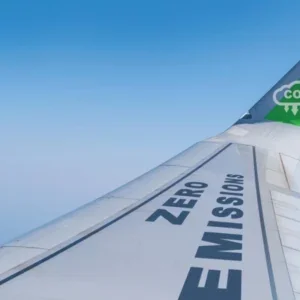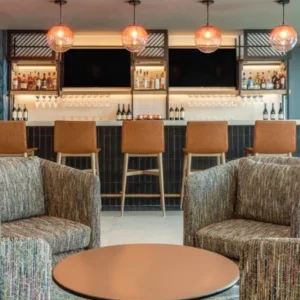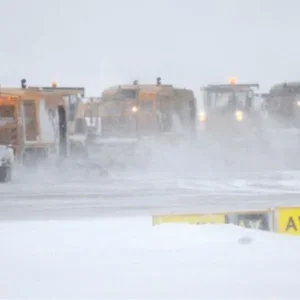On 11 December 2017, a heavy snow descended on the Netherlands, causing widespread transport chaos; hundreds of of flights were grounded at Schiphol, and Eindhoven airport closed completely.
Not to be deterred, nearly 20 representatives of Europe’s major airports convened the next day at Amsterdam’s De L’Europe hotel. They were there for Future Airport’s roundtable dinner, hosted in partnership with eezeetags, to discuss everything from biometrics to bagtags.
Of course, the weather was a recurring topic of conversation; specifically, how during snow days and other times of crisis, passengers need a personal touch. Despite the advances in technology and the move towards an automated airport experience, there was a consensus that human input is still crucial.
“Great customer experience is about the mix between the people in the airport and the technology itself, and I think we’re in a beautiful world that allows that,” said the moderator, Thomas Doogan, setting the tone for the evening. He opened the event by explaining its overriding theme: “Time to capitalise”. The night promised to look at new technologies, and explore how airlines and passengers could reap the benefits.
Selfie biometrics
He then played a video from easyJet, laying out the airline’s vision for the future. In tomorrow’s airport, the video proclaimed, easyJet’s app will unlock a seamless travel experience. After scanning their passport on their phone, passengers will take a selfie that is matched to their biometric passport information, while bagtag information is transferred to their booking.
“At bagdrop, the customer needs no documents, no boarding pass, no passport,” the video continued. “They place their bag on the belt and facial recognition confirms their identity. Facial recognition is also used to pass through security, and gate scanning allows us to board without needing to queue. A customer can be processed every six seconds and it takes eight minutes to board a full aircraft. Once on board, the customer will receive confirmation that their bag has been loaded onto the aircraft. The mobile host greets customers on arrival with baggage belt information and sends a final text thanking them for flying with easyJet.”
This may sound like an unlikely scenario, but it is one that easyJet is edging ever closer to realising. In 2016, the airline opened the world’s largest self-service bagdrop area at Gatwick Airport, with 48 (now 60) self-service kiosks. This has decreased peak queue times from an average of 22 minutes to less than five, and provides a clear example of how automation can boost passenger satisfaction.
“It’s about building the experience that’s right for the individual,” added Doogan. “When I’m in a congested space like an airport, I become really private and don’t want anybody interrupting my personal experience. But my mother needs more assistance. The beauty of personalisation is that, because people like me prefer automation, there’s more time for staff to look after my mother.”
Stick to a plan
Borry Vrieling, founder and managing director of eezeetags, gave a keynote speech after the starter. His company began life as a printing company producing labels for a leading Dutch supermarket chain.
“I knew about this special adhesive that doesn’t stick to anything but itself – it’s something like magic, and it made the whole operation far cleaner,” he recalled. “Then, five or six years ago, a Dutch bagdrop company came to us and asked how they could use this technology. That’s when I came up with eezeetags.”
A simple self-service bagtag, which is virtually impossible for passengers to get wrong, eezeetag makes the tagging process around 300% faster, which in turn makes a huge difference to queue times. Today, the tags are being used in self-service bagdrop installations in 22 countries, in collaboration with airlines like Lufthansa, easyJet and KLM.
“At the moment, 3.2 billion passengers are flying on a yearly basis, which will grow to 7.5 billion just 12 years from now,” says Vrieling, citing figures from SITA. “This challenge is something we need to look at, because if you’re not going to grow bagdrop capacity you’re going to end up with big queues.”
Vrieling and Doogan went on to discuss more ways of moving towards full automation. Both made clear that the short-term vision, more self-service machines in airports, is just a step towards something radically different. Vrieling remarked that in 20 years, bagtags probably won’t exist. While Doogan suggested that the human function will be entirely replaced by robots. He also said that easyJet wants to focus on streamlining the boarding process so everything can be done from a single touchpoint, from dropping off bags to upgrading seats.
Dissolving the boarding process
“In an ideal world, the bagdrop and the boarding experience should be as short as possible so that the airport becomes a shopping centre,” Doogan explained. “This allows airports to capitalise on the opportunity of having our customers going through their space, and it means we as airlines will pay less for the use of those spaces. We think we’re about three or four years away from having an example of frictionless travel that really works operationally.”
Following the main course and dessert – glazed duck breast followed by chocolate opera cake – the roundtable discussion grew even livelier. One particularly sticky topic was aircraft boarding, and the challenges surrounding cabin baggage.
“We have a number of concepts around how to fix these challenges,” said Doogan. “Some are about managing supply and demand, some are about creating the space within the aircraft, some are about better communications with the customer, and some are about using better algorithms so you don’t tell someone they can’t take their bag on the aircraft when there’s space.”
The delegates agreed that this was an industry-wide issue, with a number of trade-offs to be made. Introducing more locker space could improve the boarding experience, but at the cost of creating a more claustrophobic cabin. Charging for locker space would reduce the baggage on board, but only following a tricky period of customer re-education.
The conversation then moved on to the benefits and drawbacks of common-use kiosks (those shared between several different airlines), as well as the future of bagtags. Several delegates pointed out that while etags are currently expensive, the prices will soon drop and, in turn, they will be replaced by biometrics on the suitcase.
Another discussion point was on “no more kiosk”, which would involve getting rid of airport touchpoints kiosks and performing all check-ins via mobile apps outside the airport. However, as one delegate from KLM pointed out, it depends on what we consider check-in to mean.
“The word ‘check-in’ conflicts with the service we want to provide our customers. It’s a ridiculous word,” he said. “We should call it ‘welcoming the passenger’. Check-in is something administrative.”
As the wine flowed, attendees aired their frustrations around biometrics, and how regulations are preventing airlines from harnessing these technologies to their full potential.
“Today, 57% of customers are very willing to give their biometrics for an easy journey. Unfortunately, nobody can get an easy journey today because regulators don’t allow airports and airlines to share data,” said Doogan. “That’s probably the biggest challenge we have for successful automation in the coming years. Since our passengers require fast change, we require regulators to open up opportunities.”
The challenge of Resolution 753
Amid the talk of regulation, it was impossible to ignore the elephant in the room: IATA Resolution 753, which comes into force this June. Aimed at reducing the numbers of missing bags, this requirement asks member airlines to track each bag throughout the process and share all the tracking information with everyone involved in delivering the bag back to the passenger.
One airline in particular, Delta Airlines, is ahead of the curve. In 2016, Delta implemented Radio Frequency Identification (RFID) technology, which enables passengers to track their luggage in real time.
“The technology is a step towards having fewer missing bags, which is a huge cost saving for us and really appreciated by the customer,” said a delegate from Delta.
Other attendees, however, were not convinced, citing cost and sustainability challenges. Doogan was met with pained laughter when he asked the room if they were ready to meet the requirement by the summer.
By the time the night drew to a close, the complexities associated with these technologies were clearer than ever.
However, there was a note of excitement in the air about what tomorrow’s airport might look like and how airlines can work together towards that vision.
“Airlines can learn from each other and better align to make this happen,” said Doogan. “We’re at the cutting edge of innovation in terms of what we do and the products we offer in order to make our customers’ worlds easier.”






